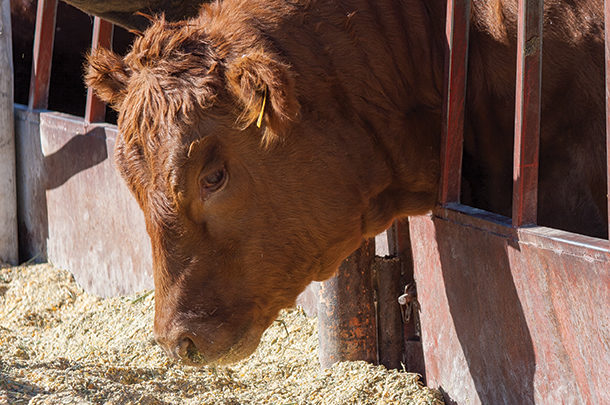Much of our industry has relied heavily on ethanol co-products to help provide protein, energy and a reliable feed source.
In the current state of affairs, many of us have had to look at different options to help support protein growth in feedlot cattle due to economic pressure on ethanol plants. Protein requirements in ruminant animals can be met with natural proteins, such as those that come from plants or those considered non-protein nitrogen compounds, such as urea.
Natural protein sources, or true protein, are often easily digested by rumen microbes. Non-protein nitrogen compounds typically have guidelines for usage, helping make them least in cost and most efficient. With the current economic situation, many nutritionists have been looking at reduced levels of distillers and bringing forth synthetic proteins or other protein byproducts to help support growth.
Commodity products that help support protein needs in feedlot cattle include rolled peas, soybean meal, distillers co-products, brewers grains, soyhulls, wheat midds, cottonseed meal, urea and ammonium salts, just to name a few. Finding the right product to work in your rations depends on the other feedstuffs that make up the ration, availability of said product and, of course, cost.
Many feedlots have had to cut back on the use of distillers products and implement the usage of urea due to cost and availability, or lack thereof, of other feed ingredients. Any change in a ration garners an understanding of the changes both the rumen environment and the feedlot animal will deal with.
When cutting back on the use of distillers, and going to supplementing protein with urea, the other demographics of the ration will change to also meet additional requirements such as net energy for gain (NEg). Corn usage or energy will have to be increased to meet the balance of energy distillers was supplying. The level of starch that changes with the increase in corn and decrease in distillers products warrants commenting on.
In many cases, we as an industry have not had to feed extremely high-starch rations, being spoiled with the low-starch, high-energy product we have with distillers. Any time you increase starch load to the rumen, you run the risk of acidosis if not adjusted or balanced properly. As an example, many finisher rations with distillers and rolled corn typically have about 45% starch, dry matter (DM) basis. When changing to non-protein nitrogen and higher corn percentages, we typically increase our finisher ration starch level to 55% DM basis or greater.
The pH level of the rumen alongside production of lactic acid in greater volume requires stringent bunk management, a watchful eye on the days on feed, attention to one’s clostridial vaccination program and perhaps the usage of tylosin phosphate, if this has been removed from the diet, to help offset any potential liver abscess issues when the liver has to work at detoxifying any excess urea and additional loads of lactic acid.
Urea usage in feedlot rations varies with type of feedstuffs to be fed with it, age and intake of feedlot cattle. Lighter-weight, more rumen-naive calves should not be fed urea until they have a more mature rumen environment and established intakes.
The goal of urea is to help make metabolizable protein (MP) through metabolism of urea to ammonia and carbon dioxide. Metabolizable protein consists of both rumen-degradable protein, or that which is degraded in the rumen, and undegradable intake protein, or that which passes to the intestinal tract for digestion. Urea assists in making protein when paired with carbohydrate substrates from energy metabolism. Urea contains about 45% nitrogen. When urea is converted to crude protein, its equivalent of urea would be about 281%. You can see, when priced accordingly, that it can be effectively used to meet rumen-degradable protein requirements in feedlot cattle.
Balancing the ration precisely when using urea is key to its success. Rapidly digesting protein sources fed with urea lead to an overwhelmed liver. Raw soybeans and rapidly digesting protein sources are at greater risk of inducing urea toxicity. Additionally, urea metabolism requires certain minerals to aid in ruminal bacteria metabolism. Phosphorus and sulfur levels, which have largely been ignored with the feeding of co-products except for in excess, may now need to be supplemented to support protein metabolism of urea.
Supplementing urea daily will provide a greater return than offset feeding due to the enzymes required to metabolize it in the rumen. Therefore, daily supplementation is suggested. One can also expect to see perhaps a slight reduction in dry matter intake (DMI) when transitioning cattle to urea-based supplements. Again, this is due in large part to the adaptation that needs to occur in the rumen to metabolize urea and a greater concentration of starch to the rumen.
Many things have changed within the past few months when facing this pandemic. One thing that is certain is: Cattle feeders are always on top of providing the best care they can for their animals and assessing their needs on a daily basis. The use of non-protein nitrogen in feedlot rations has certainly increased during this time due to the hardships of certain industries and availability of products we have learned to use and trust. We continue to provide a safe, made-in-the-USA product our consumers have come to depend on and will continue to do so throughout this pandemic and into the years to come. ![]()
PHOTO: Corn usage or energy will have to be increased to meet the balance of energy that distillers was supplying. Staff photo.

-
Heidi Doering-Resch
- Beef Technical Services
- Form-A-Feed Inc.
- Email Heidi Doering-Resch








